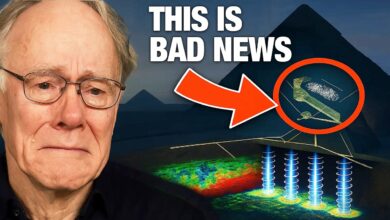Voyager 1 just made an IMPOSSIBLE Encounter in Deep Space
NASA’s Voyager missions have become iconic in the world of space exploration. Launched in 1977, Voyager 1 and 2 set out with a singular purpose: to explore the outer planets and to venture beyond the known solar system. Nearly 50 years later, these remarkable spacecraft are still sending valuable data from deep space, despite the limitations of their technology. These missions have provided us with a wealth of knowledge about our cosmic neighborhood, but recent developments surrounding Voyager 1 have raised a new set of questions—questions that might alter our understanding of the universe.
Voyager 1 and 2 were both designed during a time when computing technology was in its infancy. Their data transmission rates are a fraction of what we experience today with 5G networks, and their computing power is comparable to that of a digital watch. Yet, these spacecraft have exceeded all expectations. After nearly half a century of operation, they’ve ventured more than 12 billion miles from Earth and continue to send back groundbreaking information on cosmic rays, magnetic fields, and the very nature of deep space.
One of the key innovations that enabled Voyager to last for so long is the use of Radioisotope Thermoelectric Generators (RTGs). These devices, powered by the slow decay of plutonium, convert heat into electricity. They are designed to work in the freezing, sunlight-deprived environment of space without moving parts, making them incredibly reliable. However, as the plutonium decays, the power output naturally diminishes, and NASA engineers have had to shut down non-essential systems to preserve energy. Despite these challenges, the Voyagers continue to operate, using old-school magnetic tape systems to store data that is then transmitted back to Earth.
Over the years, Voyager 1 and 2 have delivered some of the most surprising and awe-inspiring discoveries. From Jupiter’s moons to the icy volcanoes of Neptune’s moon Triton, these probes have shown that the outer planets were far more complex than we had imagined. Voyager 1, in particular, is famous for its “Pale Blue Dot” image of Earth, taken from nearly 4 billion miles away, a haunting reminder of how small we are in the vastness of the cosmos.
Voyager’s most recent discovery, however, has caused quite a stir. In late 2023, Voyager 1’s Attitude Articulation and Control System (AACS) began sending back strange and corrupted data. The AACS, which provides critical information about the spacecraft’s orientation and operational status, was transmitting garbled messages as though the spacecraft were speaking in a foreign language. While engineers initially thought this might be a simple glitch, they later traced the issue to a corrupted memory system. However, the root cause of the glitch remains a mystery. Was this simply a hardware issue, or has Voyager 1 encountered something unexplained in the vast expanse of interstellar space?
This anomaly has raised new questions about the nature of deep space and whether Voyager 1 has encountered something outside our understanding. Some speculate that it could be the result of cosmic interference, while others are more intrigued by the possibility of discovering something truly alien. The glitch, though seemingly minor, has reignited debates about what lies beyond the solar system and whether there are forces in space that we are not yet capable of comprehending.
Voyager’s legacy is not only one of endurance but also one of discovery. It has been our eyes and ears into the vast unknown, and even though the spacecraft are aging and power is slowly fading, they continue to send back data that could change everything we know about the universe. But as the anomaly discovered in 2023 suggests, Voyager may have encountered something far more mysterious than anyone anticipated.
One of the primary objectives of the Voyager missions was to explore the boundaries of the solar system and to eventually leave it, becoming the first human-made objects to enter interstellar space. Voyager 1 crossed this boundary in 2012, followed by Voyager 2 in 2018. Both spacecraft are now in a region of space where the sun’s influence wanes, and the probe’s instruments are detecting previously unknown phenomena. One such discovery was the fluctuating nature of the heliopause, the boundary that marks the edge of the solar system. Voyager 1 also detected a persistent “hum” in the plasma surrounding the spacecraft, something that has puzzled scientists. This hum could be linked to plasma waves or, more intriguingly, it might point to something far more complex—a signal from an unknown source in the vast reaches of interstellar space.
This new discovery from Voyager 1—whether a glitch or a clue to something extraordinary—has sparked a fresh wave of scientific curiosity. Could this anomaly be a sign of alien intelligence or just a random cosmic phenomenon? As the signals from the Voyager spacecraft continue to trickle in, scientists are left to ponder not just the mission’s technical triumphs but the mysteries still awaiting us in the farthest reaches of the universe.
The next phase in our exploration of the outer solar system will come with the launch of NASA’s Interstellar Mapping and Acceleration Probe (IMAP) in 2025. This mission aims to continue the work of Voyager by studying the helopause and the outermost edges of our solar system. Perhaps it will shed more light on the strange data being received from Voyager, or it may uncover new phenomena that Voyager was unable to detect due to its age and limited technology.
In the meantime, as Voyager 1 drifts ever farther into the depths of space, scientists continue to listen, analyze, and wonder. What secrets might it reveal next? As we contemplate the legacy of Voyager, we are reminded of how far humanity has come in our quest to understand the cosmos—and how much more we still have to discover.




